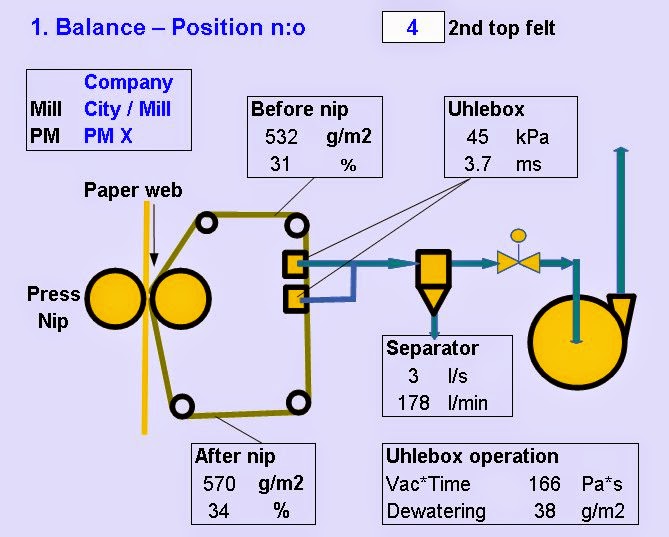1. Design principles of thick stock dosing
Stability of the operation of approach flow system (AFS) is essential when machine direction ( MD) profile of paper basis weight is controlled. Several reliable methods for dosing the thick stock to the mixing at the bottom of the ww-silo silo are available.
In this this blog we will talk about energy consumption of thick stock dosing only. Comparison is
done between stuffbox system and pressurized dosing with variable speed drive ( VSD).
Principles of the design of AFS and thick stock dosing are presented for example at TAPPI
instructions TIP 0404-54 ( http://www.tappi.org/downloads/tips/untitled-0108040454pdf.aspx )
 |
| Picture 1: Typical Stuff Box ( TAPPI - TIP 0404-54) |
2. Basis weight control of paper at stuffbox
Purpose of the stuffbox is to stabilize the incoming pressure before the basis weight valve. Constant feed pressure is arranged by running the stuffbox at constant level. Excess stockoverflows back to the machine chest. Tank levels ( machine chest, ww-silo and stuffbox)
vary from case to case, but typical values can be seen from picture 1 ( compare also
to TAPPI 0404-54).
 |
| Picture 2: Basis weight control with stuffbox |
In this example, we estimated the electric energy consumption of thick stock pump for a
machine which production is 933 tpd, and thick stock flow 287 l/s ( = 4546 gpm).
Required pump capacity is 337 l/s ( = 5348 gpm) due to the circulation of stock back to
the machine chest.
Estimated total head of the pump in this example is 19 meters ( = 61 ft) . Static head is
9 m ( = 30 ft) and pressure loss at the level control valve and piping totally 10 m ( = 33 ft).
Actual values should of cause be checked case by case.
Estimation is done with an application, that can be downloaded from KGU AppStore
( App 4.2, Feasibility of pressurized dosing compared to stuffbox , see behind the
link http://www.kgu.fi/downloads.html ).
All required input values of the calculation can be modified according to actual operation
data of the paper mill. We used in this example the default values of the application,
because they should be near by the typical operation conditions of thick stock dosing.
Normal running load (NRL) of the thick stock pump in these conditions is 81 kW ( 108 hp).
3. Pressurized thick stock dosing with VSD
Minimum energy consumption can be achieved at pressurized thick dosing system,where recirculation of the stock is eliminated, and throttle loss at control valves are
minimized with a variable speed drive ( for details, see picture 3).
 |
| Picture 3: Basis weight control with VSD system |
Normal running load of the thick stock is estimated based on the flow of 287 l/s
(= 4546 gpm), and pump total head of 9 m (30 ft), thus estimated NRL of the pump is
about 33 kW ( 44 hp).
4. Comparison of annual electric energy costs
Thick stock pump flow at VSD system is smaller, and estimated stuffbox overflow in thisexample was 15 %.
Total head of the pump at VSD system is also smaller. Static head in this example is
only 3 meters ( 30 ft).
Difference of NRL load is 48 KW ( = 64 hp), which equals to about 27000 € annual
electricity cost ( 70 € /MWh). Compare also to picture 4, estimation results from
KGU app 4.2, Feasibility of pressurized dosing compared to stuffbox).
 |
| Picture 4: Feasibility of VSD-system compared to stuff box |
5. Investment costs of required modification
Investment cost of VSD was estimated using the same formulas as at our earlierapplications ( compare to the blog Nov 2014, HP pumps).
Cost of the required piping modification was based on assumption, that about 10 meters
( = 33 ft) new piping is required. Piping material cost was assumed to be 10 € / kg, and
the additional installation and support material cost another 10 € / kg.
 |
| Picture 5: Estimated pay-out time of installation of VSD |
6. Summary
Based on these assumptions, pay-out time of improvement is about one year( = replace stuffbox with variable speed drive).
Of cause this estimation should always be checked based on the actual operation
data, and cost of electricity at the mill. Actual pump characteristics should also be
always checked.
The feasibility of VSD at thick stock dosing can be estimated with a simple application
( KGU AppStore, http://www.kgu.fi/downloads.html ).
This time the app is not free ( we need to cover our cloud and internet costs ). However
the savings are about one thousand ( = 1000 ) times higher compared to the costs of
downloading the app.
KGU Engineering
Kari U Kokkonen.

























